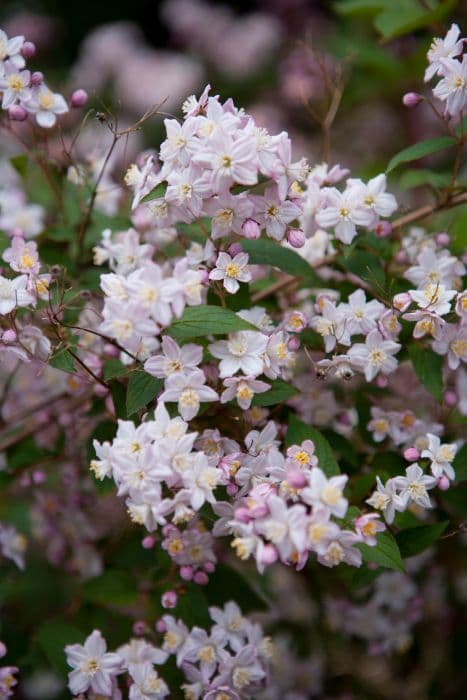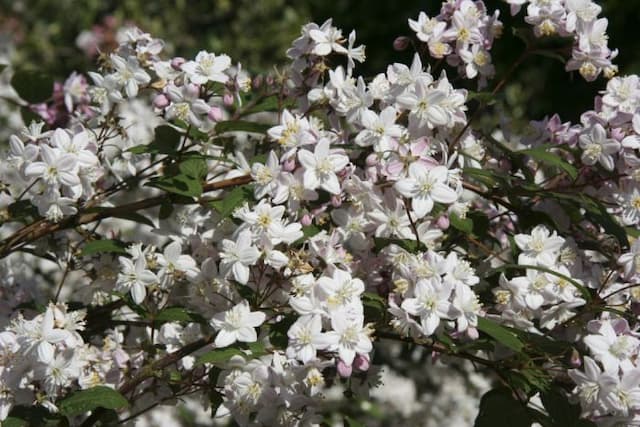Hydrangea 'Bluebird' Hydrangea serrata 'Bluebird' (L)

ABOUT
'Bluebird' is a small deciduous shrub with ovate leaves turning red in autumn. Lace-cap flower-heads with blue fertile flowers surrounded by large pale blue or pale pink sterile florets
About this plant
 Names
NamesFamily
Hydrangeaceae
Synonyms
Bluebird Hydrangea, Mountain Hydrangea, Tea Of Heaven
Common names
Hydrangea serrata 'Blue Bird', Hydrangea serrata var. acuminata, Hydrangea serrata var. angusta.
 Characteristics
CharacteristicsLife cycle
Perennials
Foliage type
Deciduous
Color of leaves
Green
Flower color
Blue
Height
4 feet (1.2 meters)
Spread
4 feet (1.2 meters)
Plant type
Shrub
Hardiness zones
6
Native area
Japan
Benefits
 General Benefits
General Benefits- Aesthetic Appeal: The 'Bluebird' hydrangea offers striking blue flowers that enhance the beauty of gardens and landscapes.
- Seasonal Interest: Blooms in late spring to summer, providing visual interest throughout the seasons.
- Attracts Pollinators: The flowers attract bees and butterflies, supporting local ecosystems.
- Versatility: Hydrangeas can be used in a variety of landscape designs, including borders, foundation plantings, and as specimen plants.
- Shade Tolerance: Unlike many flowering shrubs, hydrangeas can thrive in partial shade.
- Soil pH Responsiveness: The flower color can change from blue to pink with soil pH adjustments, adding a unique characteristic to the garden.
- Easy Propagation: Hydrangeas can be easily propagated from cuttings, making it simple for gardeners to create more plants.
- Durable: Once established, hydrangeas are relatively hardy and can withstand periods of drought.
- Cultural Significance: Hydrangeas are often associated with gratitude, grace, and beauty, making them a meaningful addition to any garden.
 Medical Properties
Medical Properties- This plant is not used for medical purposes.
 Air-purifying Qualities
Air-purifying QualitiesThis plant is not specifically known for air purifying qualities.
 Other Uses
Other Uses- Dye Production: The leaves and blooms of Hydrangea serrata can be used to make a natural dye, ranging in color from blues and purples to pinks, depending on the pH of the soil they were grown in.
- Paper Making: The fibrous bark of the Hydrangea serrata can be processed to create a type of handmade paper, known for its unique textures and strength.
- Garden Sketching: Artists can use the delicate shape and shades of Hydrangea serrata as a subject for botanical illustration, garden sketching or watercolor painting.
- Furniture Polish: Crushed leaves of the Hydrangea serrata might be used in homemade furniture polish recipes, providing a gentle abrasive and pleasant scent.
- Pastry Decoration: The flowers can serve as an elegant, organic garnish for cakes and desserts, especially when crystallized with sugar.
- Plant Markers: With their sturdy stems, dried Hydrangea serrata can be repurposed as natural plant markers for garden beds or pots.
- Photography Prop: Its vibrant flowers make Hydrangea serrata an excellent prop in product photography, lending a touch of natural beauty to the composition.
- Floral Sachets: Dried Hydrangea serrata flowers can be used to fill sachets that impart a subtle fragrance to drawers and closets.
- Frost Protection: Some gardeners use the bushy nature of Hydrangea serrata to shield smaller, more delicate plants from frost.
- Artisan Crafts: The wood from pruned branches can be carved or turned to create small artisan crafts such as buttons or beads.
Interesting Facts
 Feng Shui
Feng ShuiThe hydrangea is not used in Feng Shui practice.
 Zodiac Sign Compitability
Zodiac Sign CompitabilityThe hydrangea is not used in astrology practice.
 Plant Symbolism
Plant Symbolism- Heartfelt Emotions: Hydrangeas often symbolize deep feelings and genuine emotions, conveying gratitude for being understood.
- Apology/Reconciliation: They can be given as an apology or to express regret, suggesting a desire for reconciliation.
- Boastfulness/Arrogance: Hydrangeas have a historical symbolism tied to boastfulness due to their many blooms and lavish appearance.
- Frigidity/Coldness: The blue color of 'Bluebird' hydrangeas can sometimes be associated with turning down a romantic proposal or conveying disinterest.
- Abundance/Prosperity: The lush, full nature of hydrangea blooms can represent bounty and prosperity.
- Understanding: The hydrangea is often given as a gift to express understanding between people.
- Grace and Beauty: The delicate nature of the individual flowers and soft hues of the 'Bluebird' hydrangea suggest gracefulness and classic beauty.
 Water
WaterThe Mountain Hydrangea, commonly referred to as Hydrangea serrata 'Bluebird', should be watered deeply, ensuring the soil is kept consistently moist but not waterlogged. It's usually adequate to water this plant once or twice a week, but this might vary depending on climate and soil conditions. Each watering should be thorough enough to soak the root zone, which can mean using about 1 gallon per plant for younger plants, increasing up to 2 gallons for established shrubs during each watering session. During hot, dry spells, extra watering may be necessary to keep the soil moist.
 Light
LightMountain Hydrangea thrives in conditions where it receives morning sun and afternoon shade, which protects it from the harsh midday heat. The ideal spot is one that is bright yet sheltered, such as an eastern-facing location that catches the gentle morning light. Too much direct sunlight can lead to scorching of the leaves, while too little light can diminish blooming.
 Temperature
TemperatureThe Mountain Hydrangea prefers temperate climates and fares best with temperatures ranging from 60 to 70 degrees Fahrenheit. It can survive minimum temperatures down to about 20 degrees Fahrenheit, which accommodates most temperate regions. However, prolonged exposure to temperatures below this range may damage the plant, and protective measures should be taken if a sharp drop in temperature is expected.
 Pruning
PruningPrune your Mountain Hydrangea to maintain shape and encourage vigorous growth. The best time to prune is immediately after flowering in the late summer or early fall since it blooms on old wood. Remove dead or weak stems and cut back about one-third of the oldest stems to ground level to promote healthy, new shoots.
 Cleaning
CleaningAs needed
 Soil
SoilThe Mountain Hydrangea prefers moist, well-draining soil with high organic matter content. A mix of peat moss, compost, and a small amount of perlite or vermiculite works well. It thrives in acidic soil with a pH between 5.5 and 6.5 to maintain its blue flower coloration.
 Repotting
RepottingMountain Hydrangea should be repotted every 2-3 years to refresh the soil and provide more space for growing roots. Choose a pot slightly larger than the previous one.
 Humidity & Misting
Humidity & MistingMountain Hydrangea enjoys high humidity levels, ideally between 60% and 70%, which encourages lush growth and vibrant blooms.
 Suitable locations
Suitable locationsIndoor
Place in bright, indirect light and keep soil moist.
Outdoor
Partial shade, protect from afternoon sun, moist soil.
Hardiness zone
6-9 USDA
 Life cycle
Life cycleMountain hydrangea 'Bluebird' begins its life cycle as a seed, which when planted in well-draining soil with adequate moisture, will germinate to produce fragile seedlings. As it enters the vegetative stage, the plant develops roots and foliage, with leaves characteristic of the species. The growth continues to the formation of flower buds, often in response to increasing daylight and warmer temperatures in spring. Upon maturation, 'Bluebird' blooms, displaying its distinctive blue to pink flowers, which are influenced by the soil's pH level; acidic soils favor blue flowers, whereas alkaline soils promote pink hues. After pollination, if successful, these flowers will produce seeds, completing the reproductive cycle. The plant then goes dormant in the winter, conserving energy to restart the growth cycle in the following spring.
 Propogation
PropogationPropogation time
Spring-Early Summer
The most popular method of propagating the Mountain Hydrangea 'Bluebird' is through softwood cuttings. This technique is typically undertaken during the late spring or early summer when the plant’s new growth is still tender and green, but sufficiently matured to withstand cutting. Gardeners cut a 3 to 5 inch (about 7.6 to 12.7 cm) portion from a healthy, non-flowering stem, making a clean, angled cut just below a leaf node. The lower leaves are removed, and the base of the cutting is often dipped into a rooting hormone powder to enhance root development. Then, the cutting is gently planted in a well-draining soil mix within a pot or a tray and kept under high humidity with some form of cover to retain moisture. Consistent but gentle watering is essential until the cutting has rooted, which can take several weeks. Once the new roots have established, the young plant can be gradually acclimated to less humid conditions and eventually transplanted into the garden.







![Hydrangea [Early Sensation]](/_next/image?url=https%3A%2F%2Fplants-admin.emdemapps.com%2Fimages%2Fplants%2F%2Fimages%2F604b6150338db.png&w=640&q=75)

